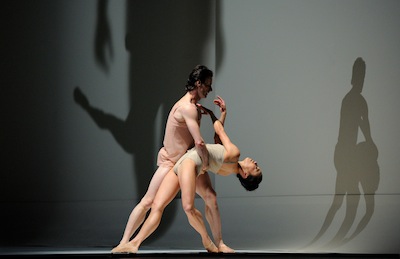
A spectrum of movement
Color is the theme of San Francisco Ballet’s Program 2, which opened on Valentine’s Day and closes on February 25. The performance begins with choreographer Wayne McGregor’s Chroma, a seething and exuberant homage to the human body in colors that make up a panorama of human skin tones.
The short tunics that just cover the torsos of the dancers are vaporous in quality and match the skin color of the bare-legged dancers that wear them: warm browns, pinks, and beiges, some of which are mauve or green in cast. Architect John Pawson designed the sets, which are simply an upstage white wall with only a large cut-out rectangle in its middle and two wall-like side sets. Lighting behind the upstage white wall changes from white to gradations of gray and black. Occasionally the dancers are side lit, their shadows cast large and gray on the side walls.
The program notes point out that McGregor’s concept is based on the definition of “chroma” as “freedom from white.” The dancers may be free of white, but only just.
The dancing is equally abstract, coursing with undulating bodies, shoulders and arms. The ballerinas, sans pointe shoes, revolve into and out of their partners’ grasp; both writhe into sameness and glisten with energy. The perfection of everyone’s sculpted and athletic bodies is given full play in the exotic partnering and shifting configurations of dancers. Joby Talbot and Jack White’s music is jazzy, percussive and, in the pas de deux, lyric and subtle.
And Morris said, Let there be color!
Mark Morris’ “Beaux” opens with the black-and-white rectangle of “Chroma” transformed into the colors of camouflage, only this is camouflage for a rose garden: hot pink, acid yellow, fuchsia and dark reds replace the familiar green, beige and brown of military clothing. Carrying the metaphor farther, the piece opens with the men, and it’s all men, standing in a line in front of this flamboyant rectangle, attentive but relaxed, their leotards a welter of pinks.
Morris is one of the great parodists of the postmodern era, and it seems as if there is always a running battle between him and ballet. He uses the vocabulary of its movement but in ways that are at times comical and almost always counter to the basic comportment of ballet. This works well with his own company but seems less successful with a ballet company. Although “Beaux” was choreographed on SF Ballet’s dancers, there were only one or two dancers who had the looseness of carriage and abandonment to movement that make Morris’ scampering choreography convincing. Even though the men who danced “Beaux” danced beautifully.
The music was Bohuslav Martinu’s Concerto for Harpsichord and Small Orchestra, played with a revival harpsichord, giving the 1935 piece a distinctly baroque flavor. Bradley Moore rocked as the harpsichord soloist.
The program closed with Christopher Wheeldon’s “Number 9.” Using composer Michael Torke’s unrelentingly kinetic and rich score, Wheeldon has put together a piece that is electrifying in its pursuit of large movements in a stage filled with dancers. Just dancing without collision seems the challenge. But San Francisco Ballet is blessed with a wonderfully trained corps that is unerring, not only in its split-second timing but in its consistency of style.
“Number 9” opens with the dancers in lemon-yellow leotards in front of a lit back scrim of ultramarine. The colors of both costumes and lighting change throughout the piece but never lose their intensity or brilliance. The same could be said of the dancers.
—Jaime Robles
San Francisco Ballet’s Program 2 runs through February 25 at the War Memorial Opera House, Van Ness Avenue and Grove Street, San Francisco. For tickets and information, visit www.sfballet.org or call 415-865-2000.
Photo: Frances Chung and Pascal Molat in Wayne McGregor’s Chroma. Photo by Erik Tomasson.
